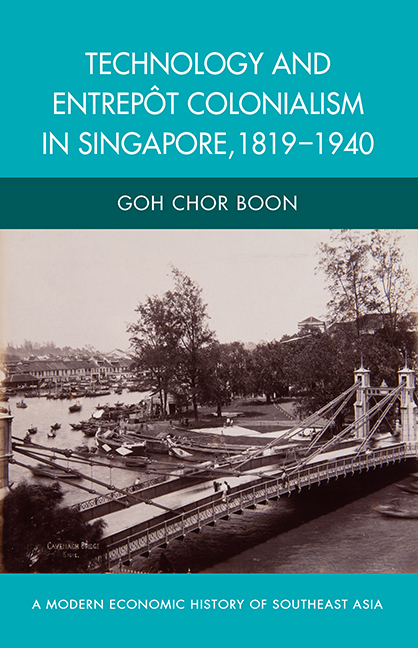Book contents
- Frontmatter
- Contents
- List of Figures and Tables
- Notes on Currency
- Introduction
- 1 Technology and the British Empire
- 2 Pioneers of Change: Entrepreneurs and Engineers
- 3 Maritime Technology and Development of the Port
- 4 Introducing Technological Systems
- 5 Sanitation and Public Health
- 6 Agriculture and Colonial Science
- 7 Food and Singapore Cold Storage
- 8 Politics of Imperial Education
- 9 Technology Transfer and Limited Industrial Growth
- Conclusion
- Bibliography
- Index
7 - Food and Singapore Cold Storage
Published online by Cambridge University Press: 21 October 2015
- Frontmatter
- Contents
- List of Figures and Tables
- Notes on Currency
- Introduction
- 1 Technology and the British Empire
- 2 Pioneers of Change: Entrepreneurs and Engineers
- 3 Maritime Technology and Development of the Port
- 4 Introducing Technological Systems
- 5 Sanitation and Public Health
- 6 Agriculture and Colonial Science
- 7 Food and Singapore Cold Storage
- 8 Politics of Imperial Education
- 9 Technology Transfer and Limited Industrial Growth
- Conclusion
- Bibliography
- Index
Summary
During the span of the Victorian Age, from 1837 to 1901, Britain's imperial trade had not only shifted the British economy and class system, but also indelibly changed its tastes and aesthetics. The last quarter of the nineteenth century saw an increasing mechanization of food production, processing and distribution for mass consumption and a corresponding expansion of the grocery trade in western Europe, especially Britain and the United States. The fledging canning industry in the United States was spurred by the need to supply food for troops during the Civil War. By 1870, agriculture in these countries became mechanized and more science-based. Food processing, such as canning and meat packing, was already done on a factory level. Rapid improvement in public transport technology enabled town dwellers to settle further and further into the countryside.
To cater to the new, greatly extended cities, new technology and processes of food preparation, preservation and transport had to be created. Food could no longer be brought from the farm to the doorstep. Without modern food technology, milk had to be boiled for much more than 12 hours, meats had to be cooked and salted and eggs pickled. But the urbanites of the early twentieth century industrial cities wanted to be pampered with the good things in life. By the 1880s new food and manufacturing technology was instrumental in meeting the changing tastes of consumers. It was now possible to produce standardized products in large volume and in small packages through the use of continuous process machinery. This led to the branded production of everything from toothpaste, chewing gum, photographic film to breakfast cereals, soups and canned products, all heavily promoted through newspaper and billboard advertisements. The increasing popularity of the English breakfast and afternoon tea created a rising demand for a wider range of manufactured biscuits, jams and factory-produced cakes amongst the working class living in the cities and suburban areas. Manufacturing firms, destined to be household names in the food industry, were established during this period and quickly monopolized some popular products. Peek Freans introduced the first “cream cracker” in the 1880s, and McVities gave the world the “digestive” biscuits in the 1890s.
- Type
- Chapter
- Information
- Technology and Entrepot Colonialism in Singapore, 1819–1940 , pp. 168 - 195Publisher: ISEAS–Yusof Ishak InstitutePrint publication year: 2013

